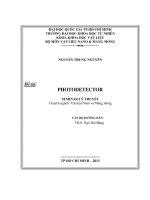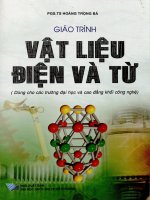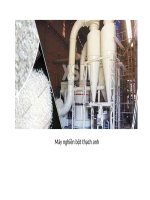Slide thuyết trình vật liệu nano và màng mỏng pram
Bạn đang xem bản rút gọn của tài liệu. Xem và tải ngay bản đầy đủ của tài liệu tại đây (852 KB, 14 trang )
.c
om
u
cu
1
du
o
ng
th
an
co
ng
PRAM
THÀNH VIÊN:
- TRẦN NGỌC HIẾU
- TRẦN MINH HẢI
- NGUYỄN TRUNG THOẠI
- NGUYỄN TRÚC MAI
- NGUYỄN HỮU THIỆN
- PHẠM MINH THUẬN
CuuDuongThanCong.com
/>
I- GIỚI THIỆU
.c
om
What is PRAM?
co
ng
The abbreviation of Parameter random access
memory.
th
an
The PRAM is classified into the Phase – Change
Memory (PCM).
u
du
o
ng
The Parameter RAM is a small amount of
"nonvolatile" RAM (NVRAM) that holds various
settings that the system can use before the operating
system loads, and maintains these settings even when
the computer is turned off.
cu
2
There is a small battery on the computer's mainboard
that helps maintain the PRAM settings when power is
off.
CuuDuongThanCong.com
/>
.c
om
What is the Phase – Change Memory?
an
co
ng
In the 1960s, Stanford R. Ovshinsky of Energy Conversion Devices first
explored the properties of chalcogenide glasses as a potential memory
technology.
du
o
ng
th
In 1969, Charles Sie published a dissertation at Iowa State University that
both described and demonstrated the feasibility of a phase-change-memory
device by integrating chalcogenide film with a diode array.
u
A cinematographic study in 1970 established that the phase-change-memory
mechanism in chalcogenide glass involves electric-field-induced crystalline
filament growth.
cu
3
I- GIỚI THIỆU
CuuDuongThanCong.com
/>
.c
om
Structure:
co
ng
PRAMs exploit the unique behaviour of chalcogenide glass.
ng
th
an
Chalcogenide glass is a glass containing one
or more chalcogens (sulfur, selenium and
tellurium, but excluding oxygen).
u
du
o
Chalcogenide compounds such as AgInSbTe
and GeSbTe are used in rewritable optical
disks and phase-change memory devices
cu
4
I- GIỚI THIỆU
By controlling heating and annealing
(cooling), they can be switched between an
amorphous and a crystalline state.
CuuDuongThanCong.com
Material
Used is called
CHALCOGENIED.
The
Group VI elements of the periodic
table.
Refers to alloys containing at least one
of these elements such as the alloy of
Germanium, Antimony, and Tellurium…
/>
.c
om
Structure:
ng
Newer PCM technology
th
an
co
ng
In the older generation of PCM, heat produced by the passage of an electric current
through a heating element generally made of TiN was used to either quickly heat and
quench the glass, making it amorphous, or to hold it in its crystallization temperature
range for some time, thereby switching it to a crystalline state.
du
o
To find viable material alternatives to Ge2Sb2Te5 (GST), with mixed success.
u
The use of a GeTe - Sb2Te3 superlattice to achieve non-thermal phase changes by simply
changing the co-ordination state of the Germanium atoms with a laser pulse.
cu
5
I- GIỚI THIỆU
This new Interfacial Phase-Change Memory (IPCM) has had many successes and
continues to be the site of much active research.
CuuDuongThanCong.com
/>
.c
om
Structure:
an
co
ng
The crystalline and amorphous states of chalcogenide glass have dramatically
different electrical resistivity values. The amorphous, high resistance state represents
a binary 0, while the crystalline, low resistance state represents a 1.
u
du
o
ng
th
The stoichiometry or Ge:Sb:Te element ratio is 2:2:5. When GST is heated to a high
temperature (over 600 C), its chalcogenide crystallinity is lost. Once cooled, it is
frozen into an amorphous glass-like state and its electrical resistance is high. By
heating the chalcogenide to a temperature above its crystallization point, but below
the melting point, it will transform into a crystalline state with a much lower
resistance.
cu
6
I- GIỚI THIỆU
The time to complete this phase transition is temperature-dependent. Cooler portions
of the chalcogenide take longer to crystallize, and overheated portions may be
remelted. A crystallization time scale on the order of 100 ns is commonly used.
CuuDuongThanCong.com
/>
.c
om
I- GIỚI THIỆU
What is its function?
co
ng
The PRAM held information for networking, but that has been removed so any
network troubles should not be affected by PRAM settings.
ng
th
an
If you have problems with any of the following then a PRAM reset might help
you out:
du
o
Volume changes or won't stick
Video resolutions not sticking or not all available
u
Time zone information and clock settings
cu
7
Boot volume isn't set (question mark shows briefly before booting)
Keyboard repeat rates
Mouse input rates (click and tracking speeds)
Default system fonts
CuuDuongThanCong.com
/>
.c
om
I- GIỚI THIỆU
co
u
du
o
ng
th
an
Because it is much closer in
speed to dynamic RAM
(DRAM), phase change
memory technology is ideal
for both non-volatile dual
in-line memory modules
(NVDIMMs) and nonvolatile memory express
(NVMe) solid state drives
(SSDs).
ng
What is its function?
cu
8
CuuDuongThanCong.com
/>
.c
om
9
What is its function?
cu
u
du
o
ng
th
an
co
ng
Apart from its speed advantage,
phase change memory technology
is also much more durable than
flash, and any concern about the
number of daily writes causing
wear-out is not an issue. PCM is
sometimes called "perfect RAM"
(PRAM) because data can be
overwritten without having to erase
it first.
CuuDuongThanCong.com
/>
.c
om
ng
co
an
th
ng
du
o
u
cu
10
II- CẤU TẠO – NGUYÊN LÝ HOẠT ĐỘNG
- The amorphous, high resistance state
represents a binary 0,
- While the crystalline, low resistance state
represents a 1.
CuuDuongThanCong.com
/>
.c
om
ng
co
an
th
ng
du
o
u
cu
11
II- CẤU TẠO – NGUYÊN LÝ HOẠT ĐỘNG
CuuDuongThanCong.com
/>
.c
om
ng
co
an
th
ng
du
o
u
cu
12
III- CHẾ TẠO
CuuDuongThanCong.com
/>
.c
om
ng
co
an
th
ng
du
o
u
cu
13
IV- ĐẶC ĐIỂM
CuuDuongThanCong.com
/>
.c
om
PRAM's temperature sensitivity is perhaps its most notable drawback, one that may require
changes in the production process of manufacturers incorporating the technology.
co
ng
PRAM's high performance, thousands of times faster than conventional hard drives, makes it
particularly interesting in nonvolatile memory roles that are currently performance-limited by
memory access timing.
th
an
PRAM devices also degrade with use, for different reasons than Flash, but degrade much more
slowly. A PRAM device may endure around 100 million write cycles.
du
o
ng
PRAM lifetime is limited by mechanisms such as degradation due to GST thermal expansion
during programming, metal (and other material) migration, and other mechanisms still unknown.
u
The contents of a PRAM, however, are lost because of the high temperatures needed to solder the
device to a board. This is made worse by the recent drive to lead-free manufacturing requiring
higher soldering temperatures. The manufacturer using PRAM parts must provide a mechanism to
program the PRAM "in-system" after it has been soldered in place.
cu
14
IV- ĐẶC ĐIỂM
PRAM devices originally stored only a single bit in each cell, but Intel's recent advances have
removed this problem.
PRAM cell selectors can use various devices: diodes, BJTs and MOSFETs.
CuuDuongThanCong.com
/>









